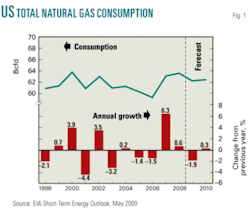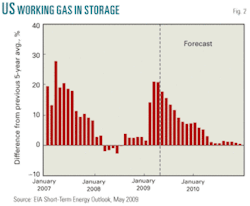Total US natural gas consumption this year will drop by nearly 2%, according to the most recent Short-Term Energy Outlook from the US Energy Information Administration. Demand next year, said the agency, will increase slightly.
Total marketed US gas production also will decline slightly this year but more steeply in 2010. As a component of natural gas supply to US markets, LNG imports will increase in 2009 and 2010.
Working gas in storage in US reservoirs on May 1, said the report, was nearly 2 tcf, more than 360 bcf ahead of the average for the last 5 years and nearly 500 bcf more than the same week in 2008.
Finally, the report stated Henry Hub spot prices are likely to average about $4/Mcf this year, rising to more than $5/Mcf in 2010.
Consumption
Total gas consumption in the US will decline by 1.9% in 2009, then increase slightly in 2010 (Fig. 1). Weak economic conditions will depress gas consumption in the influential industrial sector, as the main source behind the dip in total consumption.
Projected increase in natural gas use for electric-power generation may offset some of this decline, said the report. Lower relative natural gas prices compared with coal, particularly in the Southeast, will induce higher use of gas-fired electric generation capacity near-term and drive up consumption by 2.1% in the electric-power sector this year. Gas consumption will decline only slightly in residential and commercial sectors this year.
For 2010, as for other fuels across energy markets, said the report, the outlook for natural gas consumption is “highly contingent upon the timing and pace of economic recovery.”
Under EIA’s current assumptions, demand growth in electric power and a slight recovery in the industrial sector will drive a small increase in total consumption for 2010. This will come despite minor consumption declines in residential and commercial sectors that will result from anticipated nearly 1% fewer heating degree-days than in 2009.
Production, imports
EIA expects total US marketed natural gas production to decline by 1% this year and by 2.8% in 2010.
Poor economic conditions and lower natural gas prices by May had reduced total working natural gas rigs by 54% since August 2008. The erosion of drilling activity combined with production curtailments in response to current and projected low prices and high inventory levels will push down gas production in the Lower 48 non-Gulf of Mexico states by about 1.6% in 2009.
Marketed production from federal gulf waters, on the other hand, EIA expects to increase by 3.4% this year as production rigs damaged by Hurricanes Gustav and Ike as well as new production from offshore oil projects come on line. Despite expectations of higher prices in 2010, the “lagged effects of the downturn in drilling this year and the natural decline in productivity from existing wells” will contribute to lower production in both Lower-48 nongulf and federal gulf regions in 2010, said the report.
EIA has taken note of the considerable uncertainty among LNG observers over the outlook for global LNG balance (OGJ, May 4, 2009, p. 49). It says that expected weak gas demand in LNG-consuming countries of Asia and Europe, start-up of new liquefaction capacity (in Qatar, eastern Russia, Indonesia, Malaysia—2009; Peru and Australia—2010), and limited gas storage capacity in markets that typically rely on LNG will increase LNG available to the US.
With this in mind, EIA predicts the US will see an increase of about 500 bcf in supply via LNG imports in 2009 and another 650 bcf in 2010. But, as the debate among observers testifies, increased availability does not necessarily translate into imports. US natural gas prices have consistently been below those in Asia and Europe (see sidebar, p. 31).
Nevertheless, the highly liquid US market, with its extensive pipeline systems and burgeoning storage, may trump its low prices in attracting spot LNG cargoes by default from European and Asian markets with higher prices but less physical flexibility.
Pipeline imports, EIA said, mainly from Canada, will decline by about 7% this year as a result of suspended drilling and declining well productivity.
Inventories, prices
Working natural gas in US storage at May 1 stood at 1.9 tcf with that inventory 362 bcf above the 5-year average (2004-08; Fig. 2) and 491 bcf above the same week in 2008.
Natural gas working inventory will peak at more than 3.6 tcf at the end of October, said EIA, surpassing the previous record of slightly more than 3.5 tcf at the end of October 2007.
Working-gas inventory has typically reached maximum during the first 2 weeks of November, with the earliest seasonal peak reported the week ending Oct. 20, 2006, and the latest peak the week ending Nov. 30, 2001.
Henry Hub spot prices averaged $3.62/Mcf in April this year, $0.46/Mcf less than the average spot price in March and pushed down by slowing economic activity. EIA expects no significant rise in average spot prices before cooler temperatures arrive in the fall to increase demand for space heating.
Although the seasonal boost in gas consumption will strengthen prices, robust storage levels will dampen any upward price movement through winter 2009-10, said the report. As the expected economic improvement contributes to demand recovery in 2010, however, sustained lower production levels could lead to higher prices later in 2010. The Henry Hub spot price will average $4.06/Mcf this year and $5.21/Mcf in 2010.



